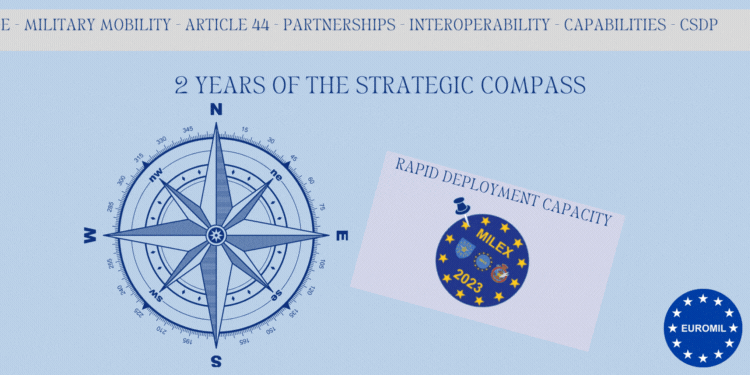Reflecting on the EU Strategic Compass: a two-year assessment!
As the European Union’s Strategic Compass approaches its second anniversary, it is time to reflect on its impact and assess where Europe stands in terms of its strategic goals and aspirations. The Strategic Compass, adopted in March 2022, one month after the start of the Russian aggression against Ukraine, was a landmark document designed to provide the EU with a common vision and direction addressing current and future challenges. Let’s once again have a look at the significance of the Strategic Compass for Europe and what progress has been made in its implementation.
We need to remember that the EU Strategic Compass is a comprehensive framework that outlines the Union’s security and defence priorities, serving as a guiding roadmap towards a more integrated Europe for Defence. It provides the Member States with principles to enhance their cooperation in various areas. In other words, it addresses a wide range of challenges, including hybrid and cyber threats, terrorism, and the resilience of critical infrastructure. Furthermore, the document also emphasizes on the importance of fostering a resilient and capable European defence ecosystem. The Compass strives to strengthen the Union’s role as a credible and reliable security provider, enhance its strategic and operational autonomy, and contribute to a safer and more secure global environment.
Since its adoption, the EU has made significant steps in several key areas. Most of the Member States have increased or are planning to increase their defence spending, and collaborative projects have been initiated to develop cutting-edge capabilities. The European Defense Fund (EDF) has played a crucial role in fostering research and innovation, while the Permanent Structured Cooperation (PESCO) has facilitated closer military cooperation among participating nations. The European Peace Facility (EPF), in operation since mid-2021, meanwhile it finances activities with military implications and supports the militaries of partner countries and EU Member States with infrastructure, training and equipment. The EPF was used in response to the Russian invasion of Ukraine to supply military equipment. The EU has also taken steps to improve its strategic communication and response to hybrid threats. Besides, defence is now being taken under consideration in policy making, as it is evident by the Space Strategy, Maritime Security, the Joint Communication on the climate-security nexus.
While progress has been made, several challenges remain. The EU faces ongoing geopolitical tensions, evolving security threats, and internal differences among member states and even sometimes among its international partners, regarding defence priorities. Achieving true strategic autonomy requires overcoming these challenges and building a consensus on the future direction of European security and defence policy. The implementation of the Strategic Compass demands sustained commitment from all Member States and effective and efficient coordination to ensure its success.
The essential point for EUROMIL as the only European umbrella organization for military personnel, is of course the challenge of having the Rapid Deployment Capacity (RDC) operational by 2025. It’s our opinion that the RDC is a much-needed capacity as the next step towards a real European Defence Union. Common exercises, as MILEX-23, demonstrate EU’s capacities in operational matters. The exercise also represents the EU’s need for common training and exercises of its personnel to test and validate its concepts, procedures and tactics. Similarly, together with future exercises – which are already under preparation – it is a step further to reach full operational capability of the Military Planning and Conduct Capability (MPCC) by 2025, which should become the EU’s preferred command and control structure, including for the EU RDC.
However, EUROMIL continues to make it a point that this extensive cooperation across borders under the European flag must go hand in hand with a synchronisation and coordination of social and working conditions and the associated protection of the personnel involved. The same challenges, the same missions also require the same protection! Military personnel, the men and women, that participate in such initiatives, are the ones that make them a reality and their rights should not be neglected.
As Europe marks the second anniversary of the Strategic Compass, it is essential to look ahead. The Strategic Compass provides a solid basis for a more integrated and capable European Defence Union, but its success ultimately depends on continued commitment, collaboration, and adaptability. In other words: the political will of the Member States is key!
To summarize, the EU Strategic Compass and without doubt the Russian invasion in Ukraine, have played a pivotal role in shaping Europe’s current approach to security and defence. While progress has been made, there are still many challenges that persist, and Europe must remain committed to the objectives it has decided in March 2022. As Europe navigates an ever-changing security landscape, the Strategic Compass serves as a crucial tool for fostering cooperation, ensuring resilience, and building a more secure future for the European Union and its citizens.
Next year, in 2025, most of the Strategic Compass’ commitments should be fulfilled, and discussions need to take place for a possible revision of the document and the need to take a step forward. The upcoming European Elections come also at a pivotal moment for Europe, and at a crucial moment for the development of Europe’s defence capabilities. Hence, the momentum is now to build a strong European Union in defence, enhance the Common Security and Defence Policy, build strong, capable, robust and interoperable Armed Forces for the security of our citizens.


